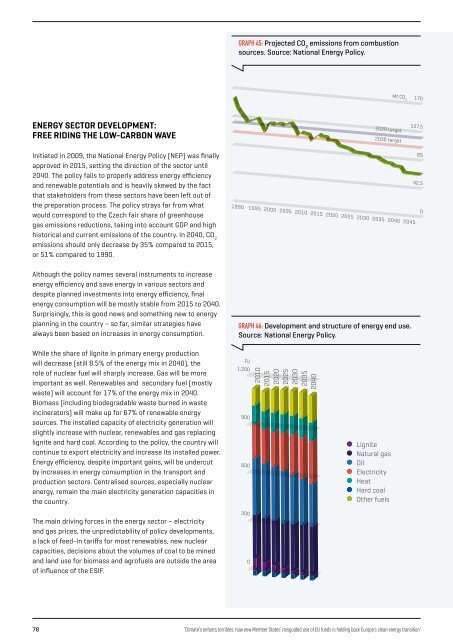ENFANTS TERRIBLES
enfants-terribles
enfants-terribles
Create successful ePaper yourself
Turn your PDF publications into a flip-book with our unique Google optimized e-Paper software.
GRAPH 45: Projected CO 2<br />
emissions from combustion<br />
sources. Source: National Energy Policy.<br />
Mt CO 2<br />
170<br />
ENERGY SECTOR DEVELOPMENT:<br />
FREE RIDING THE LOW-CARBON WAVE<br />
2020 target<br />
2030 target<br />
127.5<br />
Initiated in 2009, the National Energy Policy (NEP) was finally<br />
approved in 2015, setting the direction of the sector until<br />
2040. The policy fails to properly address energy efficiency<br />
and renewable potentials and is heavily skewed by the fact<br />
that stakeholders from these sectors have been left out of<br />
the preparation process. The policy strays far from what<br />
would correspond to the Czech fair share of greenhouse<br />
gas emissions reductions, taking into account GDP and high<br />
historical and current emissions of the country. In 2040, CO 2<br />
emissions should only decrease by 35% compared to 2015,<br />
or 51% compared to 1990.<br />
1990 1995 2000 2005 2010 2015 2020 2025 2030 2035 2040 2045<br />
85<br />
42.5<br />
0<br />
Although the policy names several instruments to increase<br />
energy efficiency and save energy in various sectors and<br />
despite planned investments into energy efficiency, final<br />
energy consumption will be mostly stable from 2015 to 2040.<br />
Surprisingly, this is good news and something new to energy<br />
planning in the country – so far, similar strategies have<br />
always been based on increases in energy consumption.<br />
GRAPH 46: Development and structure of energy end use.<br />
Source: National Energy Policy.<br />
While the share of lignite in primary energy production<br />
will decrease (still 8.5% of the energy mix in 2040), the<br />
role of nuclear fuel will sharply increase. Gas will be more<br />
important as well. Renewables and secondary fuel (mostly<br />
waste) will account for 17% of the energy mix in 2040.<br />
Biomass (including biodegradable waste burned in waste<br />
incinerators) will make up for 67% of renewable energy<br />
sources. The installed capacity of electricity generation will<br />
slightly increase with nuclear, renewables and gas replacing<br />
lignite and hard coal. According to the policy, the country will<br />
continue to export electricity and increase its installed power.<br />
Energy efficiency, despite important gains, will be undercut<br />
by increases in energy consumption in the transport and<br />
production sectors. Centralised sources, especially nuclear<br />
energy, remain the main electricity generation capacities in<br />
the country.<br />
The main driving forces in the energy sector – electricity<br />
and gas prices, the unpredictability of policy developments,<br />
a lack of feed-in tariffs for most renewables, new nuclear<br />
capacities, decisions about the volumes of coal to be mined<br />
and land use for biomass and agrofuels are outside the area<br />
of influence of the ESIF.<br />
PJ<br />
1,200<br />
900<br />
600<br />
300<br />
0<br />
2010<br />
2015<br />
2020<br />
2025<br />
2030<br />
2035<br />
2040<br />
Lignite<br />
Natural gas<br />
Oil<br />
Electricity<br />
Heat<br />
Hard coal<br />
Other fuels<br />
78<br />
‘Climate’s enfants terribles: how new Member States’ misguided use of EU funds is holding back Europe’s clean energy transition’


